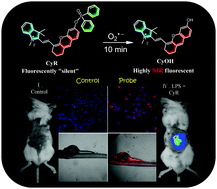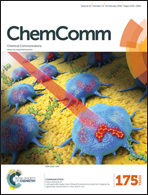A phosphinate-based near-infrared fluorescence probe for imaging the superoxide radical anion in vitro and in vivo†
Abstract
A novel near-infrared (NIR), turn-on fluorescence probe CyR containing a phosphinate group as a recognizing moiety for the selective detection of O2˙− with a low limit of detection (LOD, 9.9 nM) was developed. CyR has good cell-membrane permeability, intracellular stability, and low cytotoxicity. In addition, we successfully applied the CyR to visualize O2˙− in live zebrafish, mouse and, for the first time, in mouse liver.


 Please wait while we load your content...
Please wait while we load your content...